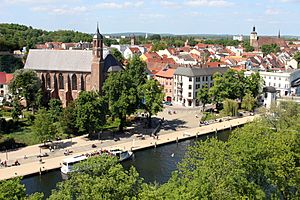Brandenburg an der Havel facts for kids
Quick facts for kids
Brandenburg an der Havel
|
|||
|---|---|---|---|

Brandenburg an der Havel in May 2015
|
|||
|
|||
| Country | Germany | ||
| State | Brandenburg | ||
| District | Urban district | ||
| Elevation | 32 m (105 ft) | ||
| Population
(2022-12-31)
|
|||
| • Total | 73,609 | ||
| Time zone | CET/CEST (UTC+1/+2) | ||
| Postal codes |
14772–14778
|
||
| Dialling codes | 03381 | ||
| Vehicle registration | BRB | ||
| Website | www.stadt-brandenburg.de | ||
Brandenburg an der Havel is a town in the state of Brandenburg, Germany. It is on the banks of the Havel river. Population: 74,129 (December 31, 2005).
The town of Brandenburg is less known than the state of Brandenburg: But the state is named after the town, and so is the medieval Bishopric of Brandenburg, the Margravate of Brandenburg. Today it is a small town compared to nearby Berlin, but once it was the start of the countries of Brandenburg and Prussia.
History
Brandenburg was only on western bank of the Havel until 1196. But even after that year the parts on either side of the river were regarded as two different towns (Old and New Brandenburg) for centuries.
In 1314 the two towns joined the Hanseatic League. In the Thirty Years' War (1618-1648) the towns were robbed and destroyed. Potsdam became the new capital, and the Royal Court left the town of Brandenburg. In 1715 the two halves of the town were merged to form a single town.
The concentration camp Brandenburg-Görden was in Görden, a suburb of Brandenburg, during the years of Nazi Germany.
After the fall of the Berlin Wall the population dropped from over 100,000 in 1989 down to roughly 75,000 in 2005 through emigration. The migration mainly affects the young people and thus the future of the city is uncertain.
Images for kids
-
Items from the Finów Hoard (Replica; Museum für Vor- und Frühgeschichte, Berlin
See also
 In Spanish: Ciudad de Brandeburgo para niños
In Spanish: Ciudad de Brandeburgo para niños


















